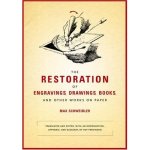
Picture yourself having just acquired an old master print (say, a Rembrandt etching) at an auction. The print is in a exceptional good state, and you bought it at a reasonable price (“reasonable” meaning in reasonable relation to the size of your wallet, of course). After the auction, this well known old print conaisseur which you watched lingering around the specimens shown at the pre-sale exhibition approaches you and tells you with that calm voice expressing a life full of old master print expertise: “Madam/Sir, I have to to tell you: your print has been Schweidlerized“.
Schweidlerized? What does he mean?
- The print is a fake (“swindle”)
- The print has been skillfully repaired, virtually invisible to the eye, or
- The print was sold (at an auction etc.) at a much higher price than what it is actually worth.
Read on for the solution and the rediscovery of a tremendously valuable book.
“Anyone who has only a small amount of time available and thinks he might be able to finish my book on the streetcar, or somewhere else in between other activities, is better off leaving my book alone. It will not do him any good. It is not just an entertaining piece of literature, a pleasant chat in more or less beautiful words.“
Thus are the introducing words of the book “Die Instandsetzung von Kupferstichen, Zeichnungen, Büchern usw.”, published first in 1938 in Berlin, a book which has long been out of print. Roy Perkinson, Head of Paper Conservation at the Museum of Fine Arts, Boston has done a very fine job in translating the text of the 1950 version and in adding eleven case studies (including woodcuts by Albrecht Altdorfer and Urs Graf; engravings by Albrecht Dürer, Marcantonio Raimondi, Antonio del Pollaiuolo, Martin Schongauer, Lucas van Leyden and the Master of the Housebook, and etchings by Rembrandt Harmensz. van Rijn and Anthony van Dyck). All quotations in this post are from this edition.
The author of the mentioned book is the German restorer Max Schweidler, born 1885 in Berlin. The year of his death is unknown, which is not the only mystery surrounding his life. His brother, Carl (1884-1962) was said to be the even more skilled restorer, but he didn’t describe any of of his methods in a publication.
Both Carl and Max Schweidler had an extensive knowledge of how to repair age-related damages of works on paper in such a perfected way that later experts would have difficulties even in spotting them. Max Schweidler specifically pointed out the results of “wrong ” (or at least different) restoration methods, thus the subtitle “Past Mistakes and New Methods…” of his book. He admits that he had to be “rather pedantic about the details” of his methods, but he found the detailed explanations absolutely necessary in order to reach the ultimate goal of his understanding of restoration: “...transmitting these treasures in the best possible condition to future generations“.
What follows is a critical overview of the methods of past restorers and a meticulous account of his own methods. Although there are inaccuracies (e.g. Schweidler’s knowledge of paper making) and procedures nowadays obsolete, Schweidler’s book can still be regarded as a seminal work in this area. Perkinson’s edition provides a cornucopia of facts about the manufacture of paper, the treatment (not necessarily removing) stains, the cleaning of prints, drawings and books and the treatment of mounted prints and much more. Perkinson briefly also touches on the interesting question of where the limits of any restoration work are. He concludes that “… in the end it is not a problem that a repair was done so well as to be almost undetectable but rather that there was no disclosure of this fact “(p. 8).
So, if there are “Schweidlerized” prints, drawings or books in your collection: congratulations for being able to discern them and respect to the work of Max Schweidler, who was indeed capable to preserve those valuable items for future generations.
Max Schweidler: The Restoration of Engravings, Drawings, Books and other Works on Paper, 2nd edition, 1950, translated and edited by Roy Perkinson. The Getty Conservation Institute, Los Angeles, 2006.
The book is available directly from the Getty Conservation Institute or from Amazon.

Max Schweidler taking a sheet out of the tray (p. 49)
Another technical study to the engraving Battle of the Nudes by Antonio del Pollaiolo (case study 11 in Parkinson’s edition) was conducted by Moyna Stanton, Associate Conservator of Works of Art on Paper at the Cleveland Museum of Art. Her findings are available online: Pollaiuolo: Finding the Pieces of the Puzzle, where you will also find additional facts on the works of the Schweidler brothers.
